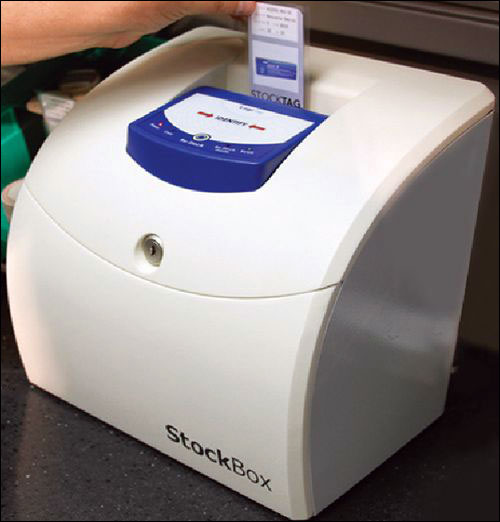Acute-care facility New York Hospital Queens, located in the Flushing section of New York City, is piloting radio frequency identification technology to help it manage its inventory of medical devices and consumables, including stents, catheters and filters used within its interventional radiology unit. The RFID solution, provided by LogiTag Systems, allows staff members to remove implants or other necessary items from a locked cabinet, and automatically creates a digital record of which items have been removed, and by whom. In addition, the system enables the hospital to maintain a record of which items were actually used during a particular procedure, via bar-code scans. In the future, says Jed Golden, New York Hospital Queens’ director of materials management, this information may be linked to existing management software, for the purpose of billing those products to that patient.
LogiTag was founded in 2004 in Netanya, Israel, to offer RFID solutions for a variety of markets, including an active RFID real-time location system (RTLS) for hospitals. Its technology is installed at every medical center in Israel, according to Glenn Tamir, LogiTag Systems’ VP of business development.

New York Hospital Queens has deployed LogiTag’s Smart Cabinet and StockBox solutions, both incorporating RFID technology compliant with the ISO 15693 standard for 13.56 MHz passive RFID tags. The Smart Cabinet, intended for tracking such high-value and time-sensitive items as implants used during surgical procedures, has a built-in RFID reader designed and manufactured by LogiTag—Tamir declines to specify the number of readers or antennas installed within each cabinet—to capture when products enter and leave its shelves, and to provide access to authorized employees. The StockBox is intended for consumables, such as surgical supplies, that are used only once. When a predetermined amount of product is consumed, an RFID tag is placed within an RFID-enabled box, thereby triggering the reordering of that item from the warehouse or stockroom.
New York Hospital Queens installed two Smart Cabinets within its interventional radiology area in January 2012, in order to test the technology, and added a StockBox this spring. If the system proves to enable it to automate inventory management at the unit, the hospital plans to install the technology at other locations within its 519-bed facility, such as the interventional cardiology and operating rooms.
As products destined for the interventional radiology unit are received at the hospital, employees attach a passive high-frequency (HF) RFID tag to each item. They then utilize a bar-code scanner to read the product’s serial number and link that information to the RFID number, as well as the product’s make, model, size and expiration date, all of which are then stored in the LogiTag software, residing on the hospital’s back-end system.
The Smart Cabinet is a locked receptacle containing five shelves, on which up to 350 implantable devices and other medical items are stored. If a hospital employee requires an implant or other items, he or she must first present an employee badge with a built-in RFID tag. The Smart Cabinet’s RFID reader captures the tag’s unique identifier and uses the LogiTag software to determine whether that individual is authorized to access that particular cabinet. If access is approved, the software sends instructions to release the lock, while simultaneously storing the ID number linked to that staff member’s identity.Multiple items may often be removed, though they may not all be used. For example, several sizes of an implant would need to be on hand during a procedure, to be used as needed. The unused items would then need to be returned. While this action is traditionally recorded by having a staff member manually write down the items’ ID numbers or scan bar codes, the Smart Cabinet automatically sends data to the back-end system indicating what has been removed, according to the tag ID numbers no longer being read, and by whom, based on that individual’s ID badge read.
Once the surgery has concluded, a worker can return to the Smart Cabinet, scan his or her ID badge and place the unused items back on the shelves, thereby causing the system to automatically indicate that those products were unused. For all items used, a bar-code system is provided by LogiTag. In this case, the products’ packaging is saved and placed within a bin, which is then moved to a bar-code scanner plugged into a PC, so that the system can link the scan data to the LogiTag software. Employees can simply access that software, click on the record of a specific patient who has undergone a procedure, and then scan the packaging’s bar codes, thus updating the system as to what was used. In the future, the hospital’s goal is to link this information with the patient’s medical record, and to prompt the issuance of an invoice for that surgery.
At the end of the day, the LogiTag software provides a report that informs management regarding which items were removed and returned to the cabinet, and by whom, as well as which were supplied to a patient or may be missing. In that way, Tamir explains, the risk of high-value medical products being lost or discarded can be greatly reduced.
New York Hospital Queens is using the StockBox system in conjunction with its existing shelves for storing consumable items. The hospital has set up a system with predetermined reorder points, whereby, when a specific quantity of items stored in a particular row on a shelf are used, the product must be replenished. With the StockBox solution, an employee places an RFID tag at each reorder point on the shelf. When the quantity of a particular product on the shelf reaches the designated reorder point, a staff member removes the tag and inserts it into the StockBox installed near the shelves.
The StockBox’s built-in RFID hardware reads the tag’s ID number and forwards that information to the StockBox software via a cabled connection. In response, the software issues a notice to authorized staff members to replenish that item. When additional supplies arrive, a worker unlocks the StockBox, removes the RFID tag and places it back at the appropriate reorder point on the shelf, signaling that inventory is now up to date in the software.
The Smart Cabinet and StockBox have enabled New York Hospital Queens to reduce excess inventory, Golden says, though it will take at least six months to determine the extent of that reduction. He notes that the system provides the added benefit of being able to automatically detect when an item is nearing its expiration date, so that the hospital can more easily ensure that inventory is not overlooked, thus reducing the likelihood of products expiring prior to use. “There is great value in that,” he states, since the hospital had to manually manage expiration dates prior to this installation.


